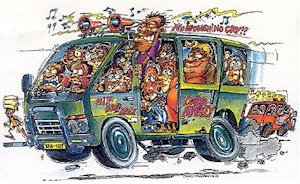What would happen if government didn’t subsidize publicly owned mass transit systems in the United States? How would millions of car-less Americans ever get around?
It may be instructive to look at the example of Nairobi, Kenya, a city of three million that hasn’t gotten around to establishing a municipal transit system yet. The private sector has arisen to meet the demand for shared ridership services. Minibuses known as matatus, which seat between 14 and 24 passengers, run along established routes with their destinations imprinted on the side. Individual buses are readily distinguishable by their paint schemes, often highlighting favorite football teams, hip-hop artists or even President Obama. Competing for business, many are equipped with powerful sound systems and television screens to attract more riders.
There are safety concerns — matatus are known for reckless driving. Moreover, the individual routes don’t cohere into an orderly system. Until very recently, there was no citywide map of all the routes. But researchers with the University of Nairobi, Columbia University and MIT have remedied the latter deficiency by mapping the routes of some 130 matatu lines, as described by this article in Atlantic Cities, and found that they provide comprehensive coverage across the metropolitan area.
“Look, these people have planned your system from below!'” said Jacqueline Klopp with the Center for Sustainable Urban Development. “It is not as chaotic as people think it is. They have routes, they have numbers. There’s very, very regular stops that the city didn’t plan. I think it really helps people to see that there is this system that you can then improve on, that it’s not just a chaotic mess.”
“When the government does not step in, these informal economies are developed to meet a certain need that the government should be taking care of,” says Sarah Williams, the director of the Civic Data Design Lab. “That’s exactly what’s happened here. And it’s fascinating to see, because it’s totally driven by need.”
Responding to safety concerns, Nairobi officials have required matatus to include seat belts and install speed regulators. More recently, the city has acted to phase out the matatus, refusing to issue any new licenses. Current matatus will be allowed to live out their lifespan. The move seems incomprehensible… unless you consider the fact that Nairobi also has four bus lines. Just a guess, the crackdown on matatus may represent classic rent-seeking by the larger, better capitalized bus companies. Hmm. Sounds very American. Too bad.
Regardless, Nairobi has a much more vibrant mass transit scene than American cities do. Part of that reflects lower incomes and the inability of most Kenyans to buy their own cars. But part of the explanation is the domination of U.S. public transit by municipal transit systems and taxicab cartels that prevent competition by anyone with a better idea. Liberal-progressive Smart Growthers can lobby for expanding subsidized mass transit, if they want. But conservative Smart Growthers should stand up for free markets. We want matatus in America.



